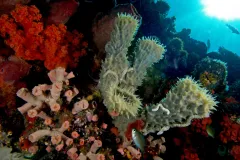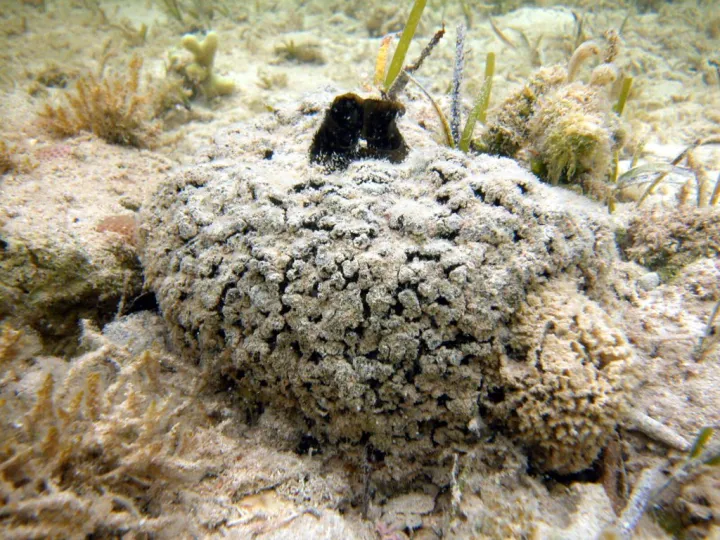Sea Sponges: Pharmacies of the Sea

Werner Bergmann did not mean to discover a lifesaving drug. But an unassuming trip to the Florida Keys to collect sea sponges would prove to be a crucial point in a search for new medicines.
Sea sponges are unassuming creatures. An amorphous and unmoving blob of porous tissue on the seafloor, it is easy to assume they aren’t even an animal. But, in fact, they are likely one of the oldest lineages of animals on the planet. They are also a treasure trove of biochemical compounds.
After collecting a new species of sea sponge off of Elliot Key in 1945, Bergmann, an organic chemist, began the search for his true passion—new types of the fat molecules called sterols. In the chemistry world during the 1940s, sterols, like cholesterol, were still largely an unknown. Sea sponges happened to be a gold mine for new and interesting sterols, and Bergmann intended to learn all he could from them.
But this new sponge, now known as Tectitethya crypta, was different. Placing the sea sponges in boiling acetone (the chemical also used in nail polish remover), Bergmann intended to leach out the sterols from the sponge’s tissue. As he did this he noticed something funny. A “rather copious amount of a nicely crystalline material” began to form in the acetone. A mysterious compound was coming from the sponge.
After analyzing the compound, Bergmann discovered that it was very similar, but not identical, to another type of molecule making headlines. The structure of DNA was still a mystery and wouldn’t be revealed as a double helix until 1953, but at the time the scientific community did know that DNA was built of smaller units called nucleosides. The crystal coming from the sponge was a nucleoside.
There are four types of nucleosides that form DNA, including thymidine, cytidine, guanosine, and adenosine. In a living cell, they are usually bound together in a chain. This new compound was different. Bergmann’s mystery compound, called spongothymidine, was almost identical to thymidine in structure, but instead of being linked in a chain with other nucleosides it was all alone.
The power of DNA lies in the combination of linked thymidines, cytidines, guanosines, and adenosines. The order in which they are bound together serves as a coded blueprint for building body parts. Alone, that power is lost. Yet, a sponge in the ocean filled its body with a single, lonely nucleoside. Why might this be?
The ability to move is a powerful survival tactic in a world of constant threats. A stalking predator can be outmaneuvered or a deadly heatwave can be escaped. But immobile creatures, like sponges, are stuck in place and must fortify themselves against whatever comes their way. One method of defense is the use of chemicals. But making a brand-new chemical from scratch is a costly endeavor. Instead, sponges tweak molecules already found in the body to serve a new purpose. This nucleoside was one of those altered molecules.
After years of experimentation, scientists discovered that nucleosides like the ones found in Tectitethya crypta are powerful chemicals that halt viral infections. These special nucleosides look so similar to the DNA building blocks that viruses are tricked into using them to build their DNA. But unlike molecules created from thymidine, cytidine, guanosine, and adenosine, these nucleosides cannot be linked in a chain, and the viral DNA construction is terminated. It turns out that this can also happen in human DNA.
The first medical drug modeled after a chemical found in a marine organism was released in 1969. Cytarabine is a nucleoside modeled after spongothymidine that blocks DNA replication in acute leukemia and lymphoma tumors, effectively killing them. It is so successful that it is still an integral treatment option in leukemia patients today. Other drugs that harnessed the mimicking qualities of nucleosides followed. Acyclovir, approved in 1981, treats herpes, chickenpox, and shingles and is on the World Health Organization's list of essential medicines, a list that includes the most effective and safe medicines used to treat the world’s most important health needs. And in 1987, AZT hit the market. A modified nucleoside, it became the first drug approved by the FDA to treat HIV and is still used in HIV treatment plans today.
Every year over 200 new chemicals are discovered from sea sponges. Some are protein-based, others are fats, and still, others are similar to DNA, like nucleosides. Out of all marine-related compounds discovered, 30 percent have come from sponges, making them the most prolific group for novel compounds. Many of these chemicals express antibacterial, antiviral, antifungal, antimalarial, or anti-inflammation properties making them great candidates for potential drugs. A select few, like the breast cancer-fighting drug Halaven and the inflammation-reducing drug Inflazyme, have risen through the clinical trial process and are now on the market. And since it takes roughly 15 years from discovery to use in humans, there will surely be more to come in the future.
The issue with sponge-based drugs, however, is their limited quantity. A chemical compound must either be harvested from the sponge, which is a laborious and ecologically damaging process, or they must be synthesized in a lab. Despite advances in chemistry, some chemicals are deemed too difficult or expensive to produce in large quantities. Many sponge-based drugs that once held great promise were dropped when it became evident that an economical way to produce them was out of reach. The hope is that sponge cells will eventually be grown in the lab, which would enable the efficient production of medical compounds and minimize harm on wild populations. But for now, a method that keeps sponge cells alive remains elusive.
While many people have never laid eyes on the ocean, our health is inextricably linked to ocean life. As our actions continue to impact the health of the ocean, it is important to decide how much we value its bounty. Stories of the success of synthetic drugs like Cytarabine, AZT, Acyclovir, and the many others now on the market provide some hope for a path forward.
Experts estimate that at best only half of the world’s sponges have been discovered. With so many unknowns it’s easy to wonder, what cures could be hidden in the ocean’s depths?


